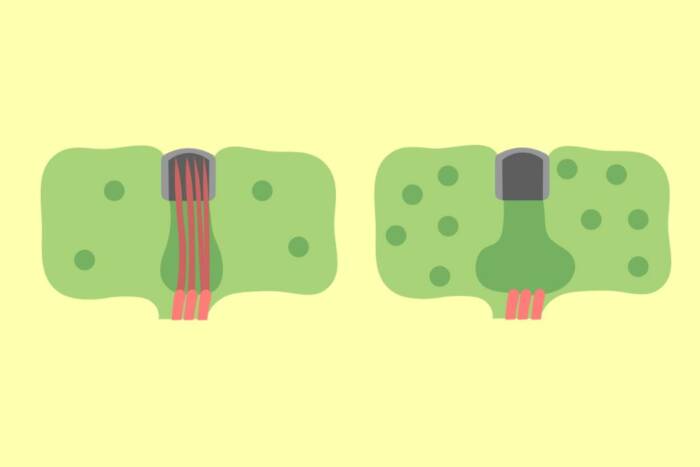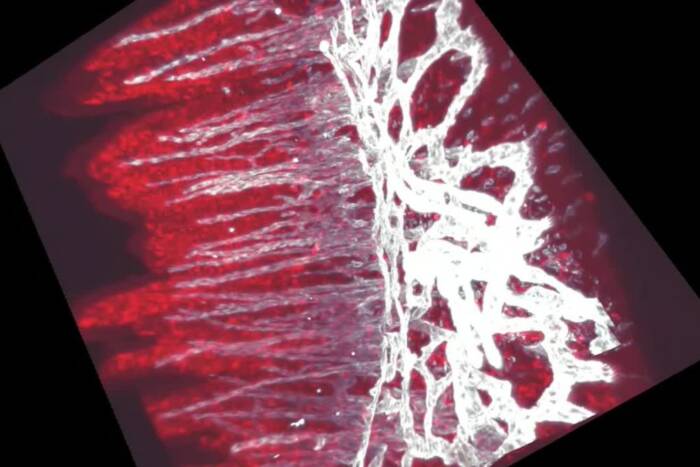Physics-biology symposium kicks off joint Rockefeller/IAS initiative
by THANIA BENIOS
An inaugural symposium named for Joshua Lederberg and John von Neumann, held in December at the Institute for Advanced Study in Princeton, New Jersey, was the first of a series of collaborative events between Rockefeller University and the IAS to be held regularly as part of a joint initiative to bring biologists, physicists, computer scientists and mathematicians together to study biological phenomena through the lens of theory and mathematics. The event, “Toward Quantitative Biology,” featured a diverse group of speakers from around the world and attracted more than 80 participants.
The symposium was designed to evoke the spirit of “undisciplined” conversation — bringing together fields that have grown further apart in their methodology and training. The talks ranged from how chromosomes are packed in the nucleus to how rates of mutation scale to the size of the genome to the neurobiology of the cricket’s auditory system, but the speakers all approached their work from a quantitative perspective. About 30 young scientists from Rockefeller, including fellows from the Center for Studies in Physics and Biology and members of experimental biology labs, made the trip to Princeton. In all, 12 Rockefeller labs were represented.
In addition to the Joshua Lederberg-John von Neumann Symposium, which will be held annually, a new monthly series of evening “chalk talks” is under way, and several scientists have also received appointments to conduct work under the auspices of the initiative. Announced last spring, the joint initiative is funded by the Simons Foundation, the philanthropy founded by Rockefeller University trustee James Simons and his wife, Marilyn Hawrys Simons, who is the foundation’s president. A distinguished mathematician, James Simons is founder and chairman of Renaissance Technologies. He is also a trustee of IAS.
The initiative is designed to build on the complementary strengths of the two institutions. “Our aim is to bring together different insights and perspectives and stimulate discussion about compelling scientific problems,” says Stanislas Leibler, head of the Laboratory of Living Matter, who now holds a joint faculty appointment with the Institute for Advanced Study. “It’s important to keep contact with different disciplines because that’s where you draw your inspiration.”
Research on biology at the IAS involves a small, highly interactive community of scientists: faculty, members and visiting scholars, all of whom do theoretical work. It is part of the School of Natural Sciences, which includes theoretical particle physicists and astrophysicists. Connections with physics and mathematics develop naturally; among members and visiting scientists many have a background in string theory, topology or computer science. In an effort to encourage collaborations, blackboards line the halls and corridors, providing a backdrop for scientists to discuss their work. In the same vein, the topics and speakers of chalk talks are left unannounced until the talk begins.
“I think the idea is to prevent scientists from prescreening their talks and to foster conversations that might be harder to find at Rockefeller,” says Natalie Arkus, a fellow at the Center for Studies in Physics and Biology who also has a visitor’s appointment at IAS. “With a wider community of scientists, the conversations are not as skewed toward one discipline or another.”
The events are not just for the benefit of members of the university’s physics center but also for the wider scientific community. “For biologists, participating in the joint initiative provides a new lens through which we can view scientific problems, think about and understand our work,” says A. James Hudspeth, who gave a chalk talk at the IAS in the fall on the auditory system and is head of the Laboratory of Sensory Neuroscience. “It gives us the opportunity to integrate different insights and perspectives into a complex problem.”
As a result of Dr. Hudspeth’s talk, Tobias Reichenbach, a postdoc in the lab, teamed up with experimentalists to mimic the ear’s amplifier with an electronic circuit that might constitute a new type of high-sensitivity microphone.
Dr. Arkus, meanwhile, has been discussing strategies with the IAS’s Arnie Levine for the development of microrobotic imaging and surgical devices that could one day replace more invasive medical procedures. “Even if most of your research is on biology or physics, it can be helpful to have conversations and interests that reach outside of it,” says Dr. Arkus.
“There is a range of biological problems that can benefit from a new look, from a fresh perspective,” says Michael W. Young, vice president for academic affairs, who was in attendance. “Our hope is that it will lead to informal conversations and visits and will ultimately help people develop new solutions and new ways of thinking about their work.”
The process is already under way in a few Rockefeller labs. Dr. Leibler and two visiting members of the IAS, Simona Cocco and Remi Monasson, have recently looked at the activity of retinal ganglion cells and used statistics derived from physics methods to infer how the cells work and influence one another. These types of projects have the potential to yield innovations in unrelated research, as well, says Dr. Leibler, who studies the interactions between organisms in particular ecological environments. “It is fascinating to think that the behavior of seemingly different systems may be elucidated by similar mathematical methods,” says Dr. Leibler. “I find it inspiring.”


